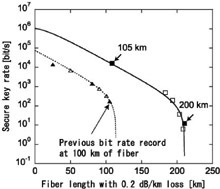@
Toshimori Honjo1, Kiyoshi Tamaki1, and Yoshihisa Yamamoto3
1Optical Science Laboratory, 2NIST, 3Stanford University
@@It is important to establish the technologies to increase key distribution
distance and key rate for realizing practical quantum key distribution
(QKD) systems. We have recently demonstrated a 200-km QKD, which set the
world record of key distribution distance, using a 10-GHz clock system
and superconducting single photon detectors (SSPD) [1].
@@Figure 1 shows the system configuration, in which the differential
phase shift (DPS) protocol is implemented [2]. At Alicefs site, a continuous
light is modulated into 10-GHz clock pulses using a high-speed intensity
modulator, and the phase of each pulse is randomly modulated by {0, Ξ}. Then, the pulses are attenuated so that the average photon number per
pulse becomes 0.2, and sent to Bob through an optical fiber. Bob inputs
the pulse train into a 1-bit delayed interferometer with which he can measure
the phase differences of adjacent pulses: if the phase difference is 0
(Ξ), the photon output from port 1 (2) and is detected by SSPD1 (2). Then,
Bob informs Alice the time instances in which he observed photons through
a conventional communication line. As a result, Alice and Bob share the
phase difference information at those time slots, which can be converted
to "keys" for one-time pad cryptography.
@@The working principle of the SSPD is explained as follows. When a photon
hits a current-biased superconducting NbN nanowire, it "breaks"
the superconductivity, and a macroscopic voltage pulse is generated. By
discriminating the voltage pulse, we can detect the arrival of the photon.
Although the current quantum efficiency is relatively small (about 1 %),
the SSPD has very low dark count rate (about 10 Hz), and so is suitable
for long-distance QKD. In addition, the SSPD can detect the 10-GHz clock
signal without suffering from errors due to inter-bit interference, thanks
to its good timing resolution (60 ps).
@@Figure 2 shows the obtained secure key rate as a function of the fiber
length. Here, the secure key rate was calculated based on a security model
considering general individual attacks [3]. We successfully distributed
secure keys over 200 km of fiber. In addition, we obtained 17-kbit/s secure
key rate at 105 km of fiber, which is two orders of magnitude larger than
the previous bit-rate record at 100 km of fiber.
@@This research was supported in part by CREST program of Japan Science
and Technology Agency and National Institute of Information and Communications
Technology of Japan.
[1] H. Takesue, et al., Nature Photonics 1 (2007) 343.
[2] K. Inoue, E. Waks, and Y. Yamamoto, Phys. Rev. Lett. 89 (2002) 037902.
[3] E. Waks, H. Takesue, and Y. Yamamoto, Phys. Rev. A. 73 (2006) 012344.
 |
 |
|||||
|
|